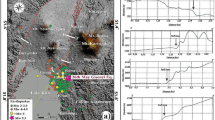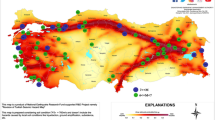Abstract
The old buildings represent an important fraction of the urban fabric of the cities, which have implicit societal issues, like safety. This work deals with the seismic vulnerability assessment and risk analysis of the old building stock, with application to a neighbourhood in Lisbon. The studied neighbourhood includes three frequent building typologies in Portugal, i.e. stone masonry, “Placa” and RC buildings. Reference buildings for each typology were numerically modelled using the equivalent frame method. Pushover analysis was then performed to derive the vulnerability characteristics of the reference buildings and more general building classes, i.e. capacity and fragility curves, in order to assess the seismic vulnerability of the buildings and perform a seismic risk analysis. This last analysis was performed to estimate the building damages and the economic and life losses for different earthquake scenarios. Most of the studied buildings are found to be unsafe to the considered seismic actions and will suffer severe damages with associated large losses.

























Similar content being viewed by others
References
ASCE/SEI 41-13 (2014) Seismic evaluation and retrofit of existing buildings. ASCE standard ASCE/SEI 41-13. American Society of Civil Engineers, Reston
ATC-40 (1996) Seismic evaluation and retrofit of concrete buildings. Report SSC 96-01. Applied Technology Council, Redwood City
Barbat AH, Pujades LG, Lantada N (2008) Seismic damage evaluation in urban areas using the capacity spectrum method: application to Barcelona. Soil Dyn Earthq Eng 28(10–11):851–865. doi:10.1016/j.soildyn.2007.10.006
Brignola A, Frumento S, Lagomarsino S, Podestà S (2008) Identification of shear parameters of masonry panels through the in situ diagonal compression test. Int J Archit Herit 3(1):52–73. doi:10.1080/15583050802138634
Brookshire DS, Chang SE, Cochrane H, Olson RA, Rose A, Steenson J (1997) Direct and indirect economic losses from earthquake damage. Earthq Spectra 13(4):683–701. doi:10.1193/1.1585975
Calvi GM, Pinho R (2004) LESSLOSS—a European integrated project on risk mitigation for earthquakes and landslides, Research Report Rose 2004/02. IUSS Press, Pavia ISBN: 88-7358-020-3
Campos Costa A, Sousa ML, Carvalho A, Coelho E (2010) Evaluation of seismic risk and mitigation strategies for the existing building stock: application of LNECloss to the metropolitan area of Lisbon. Bull Earthq Eng 8:119–134. doi:10.1007/s10518-009-9160-3
Cardona OD, Ordaz M, Reinoso E, Yamín LE, Barbat AH (2012) CAPRA—comprehensive approach to probabilistic risk assessment: international initiative for risk management effectiveness. In: Proceedings of the 15th world conference on earthquake engineering. CD-ROM, Lisbon
Cattari S, Lagomarsino S (2013) Seismic assessment of mixed masonry—reinforced concrete buildings by non-linear static analyses. Earthq Struct 4(3):241–264. doi:10.12989/eas.2013.4.3.241
CEN (2004) EN 1998-1:2004, Eurocode 8: design of structures for earthquake resistance—part 1: general rules, seismic actions and rules for buildings. European Committee for Standardization, Brussels
CEN (2005a) EN 1996-1-1:2005, Eurocode 6: design of masonry structures—part 1–1: general rules for reinforced and unreinforced masonry structures. European Committee for Standardization, Brussels
CEN (2005b) EN 1998-3:2005, Eurocode 8: design of structures for earthquake resistance—part 3: assessment and retrofitting of buildings. European Committee for Standardization, Brussels
CSI (2013) SAP2000 v12, integrated software for structural analysis and design. Computers & Structures Inc., Berkeley. http://www.csiamerica.com
D’Ayala D (2013) Assessing the seismic vulnerability of masonry buildings. In: Tesfamariam S, Goda K (eds) Handbook of seismic risk analysis and management of civil infrastructure systems. Woodhead Publishing, Sawston, pp 334–365. doi:10.1533/9780857098986.3.334
ESRI (2009) ArcGIS desktop, release 9.3. Environmental Systems Research Institute, Redlands. http://www.esri.com
Fajfar P (2000) A nonlinear analysis method for performance based seismic design. Earthq Spectra 16(3):573–592. doi:10.1193/1.1586128
FEMA & NIBS (2003) Multi-hazard loss estimation methodology: earthquake model, HAZUS-MH MR4, Technical manual, Federal Emergency Management, Mitigation Division, Washington
FEMA-440 (2005) Improvement of nonlinear static seismic analysis procedures. Federal Emergency Management Agency, Washington
Galasco A, Lagomarsino S, Penna A (2006) On the use of pushover analysis for existing masonry buildings. In: Proceedings of the 1st European conference on earthquake engineering and seismology, Paper no. 1080, Geneva
Giardini D, Woessner J, Danciu L, Crowley H, Cotton F, Grünthal G et al (2013) Seismic hazard harmonization in Europe (SHARE): online data resource. Swiss Seismological Service, ETH Zurich. doi:10.12686/SED-00000001-SHARE
IBC (2008) Norme tecniche per le costruzioni (“Italian building code”), Ministerial Decree dated of 14-01-2008. Ministero delle Infrastrutture e dei Trasporti, Rome (in Italian)
INE (2012) Censos—Resultados definitivos: Portugal—2011 (“Final results of the Census of year 2011 for all Portugal”). Instituto Nacional de Estatística, Lisbon. http://censos.ine.pt (in Portuguese)
IPQ (2010) NP EN 1998-1:2010, Eurocódigo 8—Projeto de estruturas para resistência aos sismos. Parte 1: Regras gerais, ações sísmicas e regras para edifícios, Instituto Português da Qualidade, Caparica
Lagomarsino S, Cattari S (2014) Fragility functions of masonry buildings. In: Pitilakis K, Crowley H, Kaynia A (eds) SYNER-G: typology definition and fragility functions for physical elements at seismic risk. Series on geotechnical, geological and earthquake engineering, vol. 27. Springer, Dordrecht, pp 111–156 (Chapter 5). doi:10.1007/978-94-007-7872-6_5
Lagomarsino S, Giovinazzi S (2006) Macroseismic and mechanical models for the vulnerability and damage assessment of current buildings. Bull Earthquake Eng 4(4):415–443. doi:10.1007/s10518-006-9024-z
Lagomarsino S, Penna A, Galasco A, Cattari S (2013) TREMURI program: an equivalent frame model for the nonlinear seismic analysis of masonry buildings. Eng Struct 56(11):1787–1799. doi:10.1016/j.engstruct.2013.08.002
Lamego P (2014) Seismic strengthening of residential buildings: viability of risk mitigation. PhD thesis, University of Minho, Guimarães (in Portuguese). http://www.hms.civil.uminho.pt
Lantada N, Irizarry J, Barbat AH, Goula X, Roca A, Susagna T, Pujades LG (2010) Seismic hazard and risk scenarios for Barcelona, Spain, using the Risk-UE vulnerability index method. Bull Earthq Eng 8(2):201–229
Lourenço PB, Leite JC, Paulo-Pereira MF (2009) Masonry infills and earthquakes. In: Proceedings of the 11th Canadian masonry symposium. CD-ROM, Ontario
Lourenço PB, Fernandes FM, Castro F (2010) Handmade clay bricks: chemical, physical and mechanical properties. Int J Archit Herit 4(1):38–58. doi:10.1080/15583050902871092
Maio R, Ferreira TM, Vicente R, Estêvão J (2015) Seismic vulnerability assessment of historical urban centres: case study of the old city centre of Faro, Portugal. J Risk Res 19(5):551–580. doi:10.1080/13669877.2014.988285
Marques R, Lourenço PB (2011) Possibilities and comparison of structural component models for the seismic assessment of modern unreinforced masonry buildings. Comput Struct 89(21–22):2079–2091. doi:10.1016/j.compstruc.2011.05.021
Marques R, Lourenço PB (2014) Unreinforced and confined masonry buildings in seismic regions: validation of macro-element models and cost analysis. Eng Struct 64:52–67. doi:10.1016/j.engstruct.2014.01.014
MAT (2008) Portuguese ordinance 1529-A/2008 of 28 December, Gazette of the Republic no. 249, Series 1, Ministries of Environment, Territory Planning and Regional Development, and of Labour and Social Solidarity, Lisbon (in Portuguese)
MHOPT (1983) Portuguese codes of safety and actions for building and bridge structures (RSA) and reinforced and prestressed concrete structures (REBAP). Ministry of Habitation, Public Works and Transportation, Imprensa Nacional-Casa da Moeda, Lisbon (in Portuguese)
Monteiro M, Bento R (2012) Characterization of ‘Placa’ buildings, Report ICIST DTC no. 02/2012, Instituto de Engenharia de Estruturas, Território e Construção, Instituto Superior Técnico, Lisbon. ISSN: 0871-7869
Mouroux P, Le Brun B (2006) Presentation of RISK-UE project. Bull Earthq Eng 4(4):323–339. doi:10.1007/s10518-006-9020-3
Novelli VI, D’Ayala D, Makhloufi N, Benouar D, Zekagh A (2015) A procedure for the identification of the seismic vulnerability at territorial scale: application to the Casbah of Algiers. Bull Earthq Eng 13(1):177–202. doi:10.1007/s10518-014-9666-1
Oliveira CS (2008) Lisbon earthquake scenarios: a review on uncertainties, from earthquake source to vulnerability modelling. Soil Dyn Earthq Eng 28(10–11):890–913. doi:10.1016/j.soildyn.2007.11.002
Pais J, Moniz C, Cabral J, Cardoso J, Legoinha P, Machado S et al (2006) Geological map of Portugal at scale 1:50000: explicative notice of sheet 34-D, Lisbon. Departamento de Geologia, Instituto Nacional de Engenharia, Tecnologia e Inovação, Lisbon (in Portuguese)
Park J, Bazzurro P, Baker J (2007) Modeling spatial correlation of ground motion intensity measures for regional seismic hazard and portfolio loss estimation. In: Proceedings of the 10th international conference on application of statistic and probability in civil engineering (ICASP10). CD-ROM, Tokyo
Pinho FFS, Baião MFC, Lúcio VJG, Faria P (2008) Experimental research on rubble stone masonry walls. In: Proceedings of the 1st historical mortars conference: characterization, diagnosis, conservation, repair and compatibility. CD-ROM, Lisbon
Pitilakis K, Crowley H, Kaynia A (eds) (2014) SYNER-G: typology definition and fragility functions for physical elements at seismic risk. Series on geotechnical, geological and earthquake engineering, vol. 27. Springer, Dordrecht. doi:10.1007/978-94-007-7872-6
Ripepe M, Lacanna G, Deguy P, De Stefano M, Mariani V, Tanganelli M (2014) Large-scale seismic vulnerability assessment method for urban centres: an application to the city of Florence. Key Eng Mat 628:49–54. doi:10.4028/www.scientific.net/KEM.628.49
Roque JA (2002) Strengthening and structural rehabilitation of ancient masonry walls. MSc thesis, University of Minho, Guimarães (in Portuguese). http://www.hms.civil.uminho.pt
Rota M, Penna A, Strobbia CL (2008) Processing Italian damage data to derive typological fragility curves. Soil Dyn Earthq Eng 28(10):933–947. doi:10.1016/j.soildyn.2007.10.010
Salgado-Gálvez MA, Carreño ML, Barbat AH, Cardona OD (2015) Probabilistic seismic risk assessment of Lorca through scenario simulations. Rev Internac Métod Numér Cálc Diseñ Ingr 32(2):70–78. doi:10.1016/j.rimni.2014.12.001
Santos C, Ferreira TM, Vicente R, Silva JARM (2013) Building typologies identification to support risk mitigation at the urban scale—case study of the old city centre of Seixal, Portugal. J Cult Herit 14(6):449–463. doi:10.1016/j.culher.2012.11.001
Sarraz A, Khorshed-Ali M, Chandra-Das D (2015) Seismic vulnerability assessment of existing building stocks at Chandgaon in Chittagong city, Bangladesh. Am J Civ Eng 3(1):1–8. doi:10.11648/j.ajce.20150301.11
Shing PB, Stavridis A (2014) Analysis of seismic response of masonry-infilled RC frames through collapse. ACI Struct J 297:1–20
Silva V, Crowley H, Varum H, Pinho R (2015) Seismic risk assessment for mainland Portugal. Bull Earthq Eng 13(2):429–457. doi:10.1007/s10518-014-9630-0
Simões A, Milošević J, Meireles H, Bento R, Cattari S, Lagomarsino S (2015) Fragility curves for old masonry building types in Lisbon. Bull Earthq Eng 13(10):3083–3105. doi:10.1007/s10518-015-9750-1
S.T.A. DATA (2012) 3Muri Software, release 4.0.3, S.T.A. DATA s.r.l., Torino. http://www.3muri.com
Turnšek T, Cačovic F (1971) Some experimental results on the strength of brick masonry walls. In: Proceedings of the 2nd international brick masonry conference. Stoke-on-Trent, pp 149–156
Vargas YF, Barbat AH, Pujades LG, Hurtado JE (2014) Probabilistic seismic risk evaluation of reinforced concrete buildings. Proc Inst Civ Eng Str B 167(4):327–336. doi:10.1680/stbu.12.00031
Vicente RS (2008) Strategies and methodologies for urban rehabilitation interventions: the vulnerability assessment and risk evaluation of the old city centre of Coimbra. PhD thesis, University of Aveiro (in Portuguese)
Vicente R, Parodi S, Lagomarsino S, Varum H, Silva JARM (2011) Seismic vulnerability and risk assessment: case study of the historic city centre of Coimbra, Portugal. Bull Earthq Eng 9(4):1067–1096. doi:10.1007/s10518-010-9233-3
Vicente R, Ferreira T, Maio T (2014) Seismic risk at the urban scale: assessment, mapping and planning. Proc Econ Finance 18:71–80. doi:10.1016/S2212-5671(14)00915-0
Acknowledgements
This work was partly financed by FEDER funds through the Competitivity Factors Operational Programme—COMPETE and by national funds through FCT—Foundation for Science and Technology, within the scope of the Project POCI-01-0145-FEDER-007633. The study was supported by FCT within ISISE, Project UID/ECI/04029/2013. The authors would like to acknowledge the partial support given to this work within the frame of the Research Project PTDC/ECM/101201/2008, funded by FCT. The Postdoc Grant SFRH/BPD/94677/2013 provided by FCT to the last author is also acknowledged.
Author information
Authors and Affiliations
Corresponding author
Rights and permissions
About this article
Cite this article
Lamego, P., Lourenço, P.B., Sousa, M.L. et al. Seismic vulnerability and risk analysis of the old building stock at urban scale: application to a neighbourhood in Lisbon. Bull Earthquake Eng 15, 2901–2937 (2017). https://doi.org/10.1007/s10518-016-0072-8
Received:
Accepted:
Published:
Issue Date:
DOI: https://doi.org/10.1007/s10518-016-0072-8




